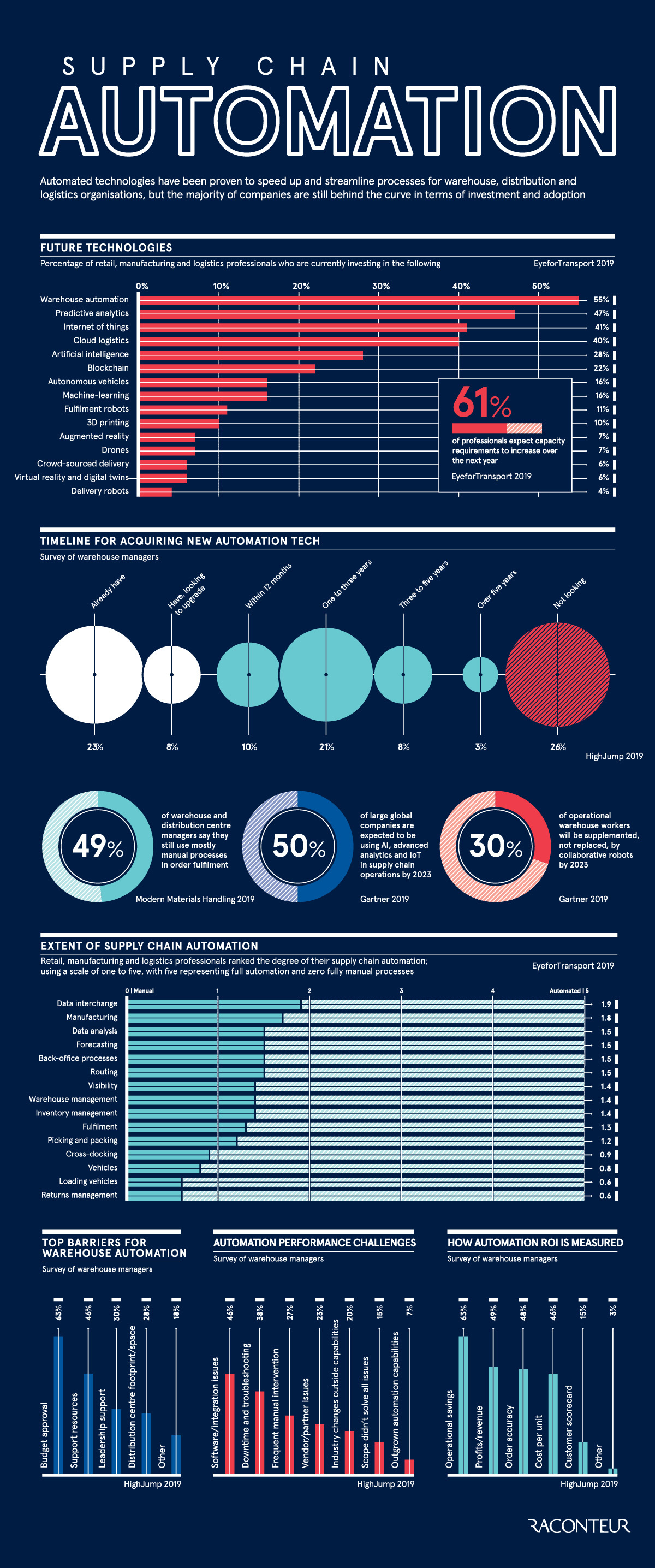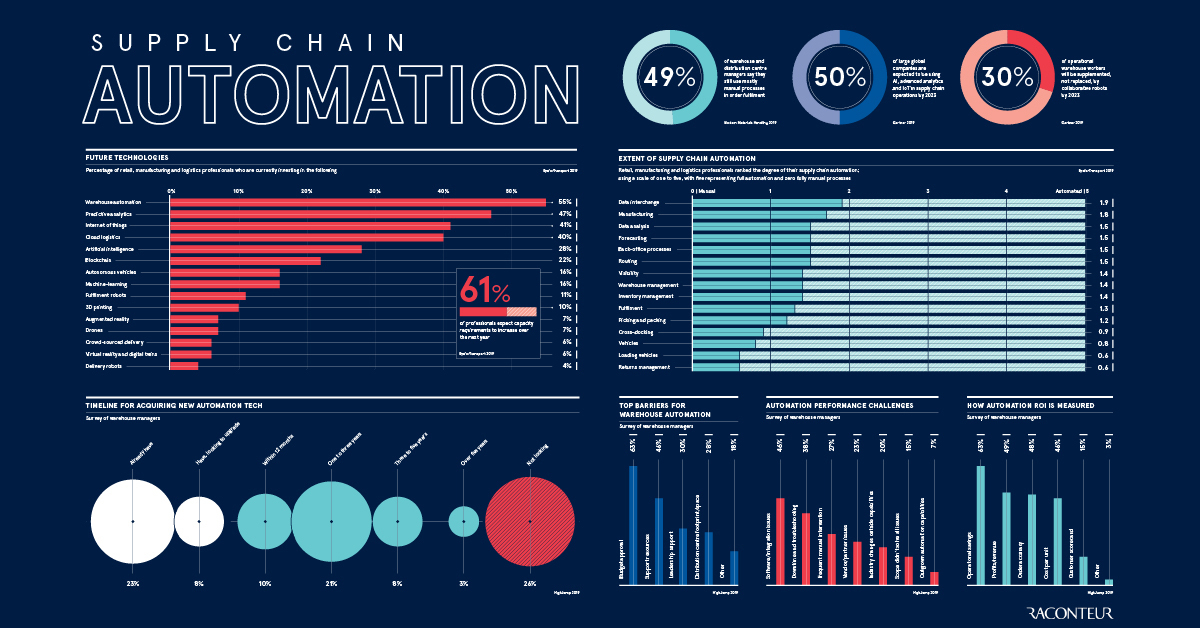Technology
The Future of Supply Chain Automation

The Future of Supply Chain Automation
As Amazon continues to set the bar for efficiency by integrating an astounding spectrum of automation technology, it’s becoming increasingly apparent that traditional supply chain models are ripe for disruption.
For this reason, companies around the world are now rethinking their warehouse and distribution systems, with automation taking center stage.
Today’s infographic from Raconteur highlights the state of automation across global supply chains, while also providing an outlook for future investment.
Long Time Coming
Let’s start by taking a look at what supply chain technologies are priorities for global industry investment in the first place:
| Rank | Technology | % of Companies* Investing in Tech |
|---|---|---|
| #1 | Warehouse automation | 55% |
| #2 | Predictive analytics | 47% |
| #3 | Internet of things | 41% |
| #4 | Cloud logistics | 40% |
| #5 | Artificial intelligence | 28% |
| #6 | Blockchain | 22% |
| #7 | Autonomous vehicles | 16% |
| #8 | Machine-learning | 16% |
| #9 | Fulfillment robots | 11% |
| #10 | 3D printing | 10% |
| #11 | Augmented reality | 7% |
| #12 | Drones | 7% |
| #13 | Crowd-sourced delivery | 6% |
| #14 | Virtual reality and digital twins | 6% |
| #15 | Delivery robots | 4% |
*Based on survey of supply chain professionals in retail, manufacturing, and logistics fields
As seen above, warehouse automation has already received more investment (55%) than any other supply chain technology on the list, as companies aim to cut delivery times and improve overall margins.
Interestingly, other areas receiving significant investment—such as predictive analytics, internet of things, or artificial intelligence—are technologies that could integrate well into the optimization of supply chain automation as well.
Smoothing the Transition
While fully automated supply chains in most industries may still be a few years away, here is how companies are investing in an automated future today:
| Timeline For Acquiring New Automation Tech | % of Warehouse Managers Surveyed |
|---|---|
| Already have | 23% |
| Have, looking to upgrade | 8% |
| Within 12 months | 10% |
| One to three years | 21% |
| Three to five years | 8% |
| Over five years | 3% |
| Not looking | 26% |
According to the above data, over 70% have already integrated automation technology, or are planning to within the next five years. On the flip side, over a quarter of warehouse managers are not currently looking to integrate any new automation tech into their operations at all.
Adoption Rates and Growth
As supply chain automation gains momentum and industry acceptance, individual processes will have varying adoption rates.
Take order fulfillment, for instance. Here, only 4% of current operations are highly automated according to a recent survey from Peerless Research Group:
| Order Fulfillment Operations (Picking and Packaging) | Percentage of Respondents |
|---|---|
| Highly automated | 4% |
| A mix of automated and manual processes | 42% |
| Mostly or all manual | 49% |
| Not applicable | 5% |
Meanwhile, 49% of operations were primarily manual, illustrating potential for growth in this particular area.
It’s worth noting that other individual supply chain components, such as conveyor belts, storage, automated guided vehicles, and shuttle systems, will all have differing trajectories for automation and growth.
Post-COVID Supply Chains
The COVID-19 pandemic has shown us that complex supply chains can become fragile under the right circumstances.
As supply chains see increased rates of automation and data collection becomes more integrated into these processes, it’s possible that future risks embedded in these systems could be mitigated.
Technology
Ranked: Semiconductor Companies by Industry Revenue Share
Nvidia is coming for Intel’s crown. Samsung is losing ground. AI is transforming the space. We break down revenue for semiconductor companies.
Semiconductor Companies by Industry Revenue Share
This was originally posted on our Voronoi app. Download the app for free on Apple or Android and discover incredible data-driven charts from a variety of trusted sources.
Did you know that some computer chips are now retailing for the price of a new BMW?
As computers invade nearly every sphere of life, so too have the chips that power them, raising the revenues of the businesses dedicated to designing them.
But how did various chipmakers measure against each other last year?
We rank the biggest semiconductor companies by their percentage share of the industry’s revenues in 2023, using data from Omdia research.
Which Chip Company Made the Most Money in 2023?
Market leader and industry-defining veteran Intel still holds the crown for the most revenue in the sector, crossing $50 billion in 2023, or 10% of the broader industry’s topline.
All is not well at Intel, however, with the company’s stock price down over 20% year-to-date after it revealed billion-dollar losses in its foundry business.
| Rank | Company | 2023 Revenue | % of Industry Revenue |
|---|---|---|---|
| 1 | Intel | $51B | 9.4% |
| 2 | NVIDIA | $49B | 9.0% |
| 3 | Samsung Electronics | $44B | 8.1% |
| 4 | Qualcomm | $31B | 5.7% |
| 5 | Broadcom | $28B | 5.2% |
| 6 | SK Hynix | $24B | 4.4% |
| 7 | AMD | $22B | 4.1% |
| 8 | Apple | $19B | 3.4% |
| 9 | Infineon Tech | $17B | 3.2% |
| 10 | STMicroelectronics | $17B | 3.2% |
| 11 | Texas Instruments | $17B | 3.1% |
| 12 | Micron Technology | $16B | 2.9% |
| 13 | MediaTek | $14B | 2.6% |
| 14 | NXP | $13B | 2.4% |
| 15 | Analog Devices | $12B | 2.2% |
| 16 | Renesas Electronics Corporation | $11B | 1.9% |
| 17 | Sony Semiconductor Solutions Corporation | $10B | 1.9% |
| 18 | Microchip Technology | $8B | 1.5% |
| 19 | Onsemi | $8B | 1.4% |
| 20 | KIOXIA Corporation | $7B | 1.3% |
| N/A | Others | $126B | 23.2% |
| N/A | Total | $545B | 100% |
Note: Figures are rounded. Totals and percentages may not sum to 100.
Meanwhile, Nvidia is very close to overtaking Intel, after declaring $49 billion of topline revenue for 2023. This is more than double its 2022 revenue ($21 billion), increasing its share of industry revenues to 9%.
Nvidia’s meteoric rise has gotten a huge thumbs-up from investors. It became a trillion dollar stock last year, and broke the single-day gain record for market capitalization this year.
Other chipmakers haven’t been as successful. Out of the top 20 semiconductor companies by revenue, 12 did not match their 2022 revenues, including big names like Intel, Samsung, and AMD.
The Many Different Types of Chipmakers
All of these companies may belong to the same industry, but they don’t focus on the same niche.
According to Investopedia, there are four major types of chips, depending on their functionality: microprocessors, memory chips, standard chips, and complex systems on a chip.
Nvidia’s core business was once GPUs for computers (graphics processing units), but in recent years this has drastically shifted towards microprocessors for analytics and AI.
These specialized chips seem to be where the majority of growth is occurring within the sector. For example, companies that are largely in the memory segment—Samsung, SK Hynix, and Micron Technology—saw peak revenues in the mid-2010s.
-

 Real Estate2 weeks ago
Real Estate2 weeks agoVisualizing America’s Shortage of Affordable Homes
-

 Technology1 week ago
Technology1 week agoRanked: Semiconductor Companies by Industry Revenue Share
-

 Money1 week ago
Money1 week agoWhich States Have the Highest Minimum Wage in America?
-

 Real Estate1 week ago
Real Estate1 week agoRanked: The Most Valuable Housing Markets in America
-

 Business2 weeks ago
Business2 weeks agoCharted: Big Four Market Share by S&P 500 Audits
-

 AI2 weeks ago
AI2 weeks agoThe Stock Performance of U.S. Chipmakers So Far in 2024
-

 Misc2 weeks ago
Misc2 weeks agoAlmost Every EV Stock is Down After Q1 2024
-

 Money2 weeks ago
Money2 weeks agoWhere Does One U.S. Tax Dollar Go?














